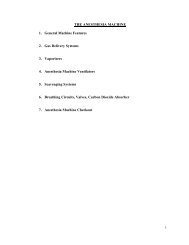BUMC Basics.pdf - Anesthesia Home
BUMC Basics.pdf - Anesthesia Home
BUMC Basics.pdf - Anesthesia Home
Create successful ePaper yourself
Turn your PDF publications into a flip-book with our unique Google optimized e-Paper software.
85<br />
MECHANICAL VENITALTION<br />
Oxygen support<br />
Nasal Cannula (NC)<br />
• Each L adds about 3% FiO2 therefore 1L is 24% FiO2<br />
w/ max of 6L and thus Max FiO2 of about 40%<br />
Venturi Mask (VM): Can set an FiO2<br />
• Max FiO2 of 50%<br />
Partial ReBreather (PRB) Mask w/ Reservoir Bag (exhaled<br />
gas mixes with bag oxygen)<br />
• Max FiO2 of 75%<br />
Non-ReBreather (NRB) Mask w/ Reservoir Bag (exhaled gas<br />
does not mix with bag oxygen)<br />
• Max FiO2 of 100%<br />
Types of ventilatory support<br />
Noninvasive Positive Pressure Ventilation (NPPV)<br />
Face/Nasal Mask Continuous Positive Airway Pressure<br />
(CPAP): One continuous pressure during inspiration and<br />
expiration<br />
Uses: Patients whose primary problem is hypoxemia;<br />
typically used with CHF patients as well as OSA<br />
Face/Nasal Mask Bilevel Positive Airway Pressure (BiPAP):<br />
Set different inspiratory/expiratory pressures<br />
Uses: Patients whose primary problem is hypoventilation<br />
or hypoxemia such as COPD, immunocompromised, postextubation<br />
especially if patient is high risk, DNI patients,<br />
PNA, etc.<br />
Inspiratory Pressure (IP): Start at 8 to 10 cm of H2O and<br />
increase as tolerated to improve Tidal Volume (TV) and<br />
decrease work of breathing, which will result in decreased<br />
pCO2.<br />
Expiratory Pressure (EP) ~ PEEP start at 4 to 5 cm of H2O and<br />
increase as tolerated to increase PO2.




